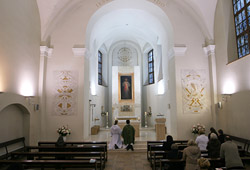Traditions of Piety
In his revelations to St Faustina, Jesus promised that those who venerate the painting would move forward on the path toward Christian perfection, die well and receive other graces. “The soul that venerates this painting will not perish,” he told Sister Faustina. “The greatness of this image is due not to the paint or the artistic beauty, but to my graces,” he said to console her when she wept that the painting was not as beautiful as her vision. Jesus promised to defend the cities and villages where the image is venerated, and to watch over all those who trust in the Lord’s mercy. This message spread rapidly among Vilnius residents of every nationality. Father Sopocko, in order to help Sister Faustina with the mission she had received from God, himself boldly proclaimed God’s mercy. He encouraged her to write the diary that became the source of devotional practices linked with the Divine Mercy.
The first public veneration of the painting took place in 1935 at the Gate of Dawn on the Friday, Saturday and Sunday after Easter. These were the last three days of the Jubilee Year of the Redemption. After Sister Faustina died in 1938, her diary was ready and the secrets of her visions became known. Father Sopocko received permission from the diocesan authorities in Vilnius to speak publicly about the origin of the Merciful Jesus painting. At the same time, the imprimatur was granted to print Polish and Lithuanian versions of the Divine Mercy Chaplet and small pictures with the Merciful Jesus image. These became highly cherished devotional items during World War II. Among soldiers, photocopies of the image were widespread.
Even during the difficult conditions of the Soviet era, the painting constantly attracted crowds of pilgrims as it was moved from place to place. More people yet prayed in private before reproductions of the image. When the Congregation for the Doctrine of the Faith announced in 1978 that it did not oppose devotion to the Merciful Jesus based on Sister Faustina’s visions, copies of the image began to multiply all over the world. Pope John Paul II contributed to spreading the Divine Mercy Devotion when he wrote about its theological foundations in the 1980 encyclical Dives in Misericordia, when in 1993 he declared Sister Faustina “blessed”, and when he canonized her in the year 2000. While visiting Vilnius, the Holy Father prayed by the image of the Merciful Jesus, which at the time was in the Church of the Holy Spirit.
The Divine Mercy Chaplet is a prayer that Jesus himself dictated during an apparition to St Faustina in Vilnius. It is recited while holding ordinary rosary beads. At the Divine Mercy Shrine, the Chaplet is recited or sung every day after the Holy Mass in Lithuanian, and before the Holy Mass in Polish. On the nine days from Good Friday to on the Sunday after Easter, in preparation for the solemn feast of the Divine Mercy the Chaplet is prayed for special intentions that St Faustina herself wrote: first of all for sinners, for those who are far from God or whose faith has become cold and so on.
Jesus gave Sister Faustina to understand, at a moment when she was sick and confined to bed, that he desired special reverence for the hour of his death, 3 o’clock in the afternoon, which is an hour of great mercy. There are always many devout souls in the shrine at that time of day, some adoring the Most Blessed Sacrament, others making the Way of the Cross. The doors of the sanctuary, which look out on a bustling Old Town street, are open all day. Outdoor speakers transmit the prayer “Have mercy on us and on the whole world”, drawing the attention of passers by, and especially of the students who hurry past on their way to the university.








